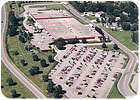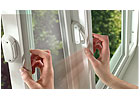
After years of manufacturing contracts moving overseas, the tide is turning. It’s not sweeping the manufacturing community all at once, but bit by bit, contract by contract, U.S. companies are realizing that American ingenuity and quality are not only superior to that of overseas suppliers, but also more affordable.
“Five years ago, there was a real push to move production-particularly component creation-overseas,” says Dominic Korbel, director of assembly value streams at Truth Hardware. “Every article painted doom and gloom for the industry, with Asia offering equal facilities with much cheaper labor. With the bottom line always in mind, our customers began...to buy from offshore suppliers.”
Fast-forward five years: After experiencing firsthand what it’s like to source directly from Asian manufacturers, as well as feeling the effect of losing customers to offshore suppliers, we refocused in a familiar direction-the United States. For reasons both intangible and quantifiable, we reached the same conclusion as several of our top customers: When it comes to manufacturing, there’s no place like home.

Keeping production in the United States allows Truth Hardware to be more responsive to customer needs.
Exploring Asia
To remain cost-competitive with our peers, we did contract with Asian suppliers to provide components for our window and door hardware. Ultimately, however, these relationships did not deliver the cost savings that we originally imagined. “The weakening dollar-to-yen currency exchange was not working in our favor,” recalls Korbel. “With the yen fluctuating more and more within global markets, we [had difficulty] preserving the financial advantage of going overseas.“We decided to source from overseas depending on where we could get the best quality, price, service and delivery to meet our customers’ needs. But eventually, that was not what we were getting. For instance, as stricter enforcement of labor laws and environmental regulations came about, Asian manufacturing costs started to rise.”
In addition, the rising price of petroleum increased shipping expenses, inflating the ultimate cost of our products across the whole value stream. “It’s not even the high cost of oil, necessarily, that causes problems-it’s thevariabilityin the price,” says Korbel. “With transportation costs potentially changing from week to week, it’s difficult to quote prices with confidence if you’re dependent on factors beyond your control.”
We also lost confidence in pricing because of various shipping-related surcharges, which made tracking true costs difficult in our accounting systems. These one-time costs were eventually added to the price of our products, but they were “sticky.” They tended to factor into the price of other products, if we weren’t careful.
Despite these issues, we still have certain die casting operations done in Asia, simply because our overseas partner offers a process that is not currently available at our Owatonna plant. “If we ship something as a Truth product, we make absolutely sure [it meets our quality and engineering standards],” says Korbel.

Selling directly to OEMs, Truth Hardware designs and manufactures hinges, locks and operators for wood, vinyl, metal and fiberglass windows, skylights and patio doors.
Going Lean
Since our customers were performing the same cost-benefit analysis of offshore manufacturing, we realized opportunity was knocking. Our challenge was to find ways to be more responsive to our customers’ needs and still compete against offshore pricing. For help, we turned to David M. Rucker, president of Rucker & Associates (Raleigh, NC), a consulting firm specializing in lean manufacturing and Six Sigma improvement methods.“Lean manufacturing originated with the Toyota Production System in Japan, and is characterized by focusing every resource on creating product value-and nothing else,” says Rucker. “Lean means that as you eliminate waste of any kind, the quality of your product immediately improves, while your production time line and costs are minimized.”
We implemented Rucker’s recommendations aggressively. As a result, productivity steadily increased across most of our production lines. Our lead times are shorter, and we can fill orders more quickly. As we improved our ability to manufacture our products, we freed up capacity to service more customers, better.
Lean helped us eliminate waste and focus our capacity completely on making good product. Our new pull-based scheduling system has allowed us to increase the number of shelf stock items we offer, even as we reduced our overall inventory.
But, that’s only part of the equation in reclaiming business lost to Asian suppliers.
Top Service Without Exception
In the past, foreign threats to domestic production were often trumped by American innovation. That’s no less true today. “Our competition, domestic or foreign, simply does not have the level of engineering and technical support talent that we have,” says Tim Pelton, vice president of operations. “[Offshore companies] don’t have the ability to modify...a new product, or change a design to meet special needs, or come up with a way to accommodate a custom request. And that’s where we-and a lot of American suppliers-really shine.”
Another aspect of manufacturing-service-is just as important to remaining competitive in the global marketplace. Sure, an offshore manufacturer can supply what you need for a lot less than you’re paying now. However, you may have to buy an entire container-load at a time. If something changes in your product offering, you’re stuck with a lot of inventory to use up before you can implement the new product. That can be costly. According to research from the Council of Supply Chain Management Professionals (Lombard, IL), warehousing costs have surged in recent years.
Outsourcing can cost you in other ways, too. The recent recalls of toys, pet food and even toothpaste remind us that quality control is still an issue with some overseas manufacturers. Yet another complication is the sheer distance between supplier and customer, which creates significant lag times.
We’re not the only company to notice that overseas suppliers are not automatically the best solution. A recentWall Street Journal article revealed that Wal-Mart Stores Inc. (Bentonville, AR) is following a similar path. Concerned about sustainability, Wal-Mart is ordering its international suppliers to eliminate waste, downsize packaging and improve transportation fuel efficiency by 2010. Such mandates could level the playing field for cost-conscious domestic manufacturers.

Keeping production in the United States allows Truth Hardware to be more responsive to customer needs.
Man Bites Dog
As manufacturing shifts back to North America, OEMs are, ironically, feeling the same pinch as their suppliers were five years ago. What started as the ability to outsource a small component or line extension has come full circle: Offshore manufacturers are expanding to offer the same product lines as their customers. “We’re in the middle of it right now,” says Pelton. “It’s sort of a ‘man bites dog’ situation.”To compete, OEMs are looking to differentiate their products from the competition, and that can only benefit domestic suppliers. To differentiate their brands, OEMs want exclusive features in their product offerings-a special function, a unique design or a product for a specific market. “As such, they no longer want a container-load of any particular component,” says Pelton. “The good news is, we [can provide that] sort of design flexibility and...deliver in quantities that let them work through their inventories. It’s a key difference between working offshore and working with us.”
Other differences are less tangible. When working with domestic suppliers, OEMs know that a quality check or expert help is just a phone call away.
“There are so many details in manufacturing,” observes Pelton. “For instance, in the window and door industry, it’s not just the unit size, but how the hardware is applied and where it’s applied. All these factors make sure that a window or door operates at maximum performance.
“Ultimately, the best customer service comes from knowledge-engineering expertise and technical know-how. [Because we’re] close enough to respond to questions and ideas, we can make sure our product does everything they want it to do. We’re not just shipping it off and cashing the check.”